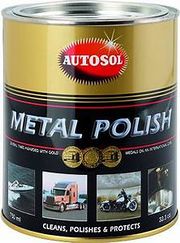Difference between revisions of "Autosol Metal Polish"
| (9 intermediate revisions by the same user not shown) | |||
| Line 1: | Line 1: | ||
| − | [[File: | + | [[File:Autosol solid metal polish.jpeg|thumb|Autosol Metal polish]] |
== Description == | == Description == | ||
| − | [Autosol LLC Otto Durst & Co.] A trademark for a series of metal polishes that were first developed in 1929 by Otto Durst, a German metalworker, for cleaning ornamental fences. Autosol® Metal Polish is a white, abrasive paste designed to remove rust and oxides from metal. The polish contains a fine-grain [[aluminum%20oxide|aluminum oxide]] powder dispersed in aqueous soap solution with small amounts of solvent, oil, and ammonia. The cleaner produces a high gloss finish. After polishing, some pieces may have a thin residual oil film and/or white powder in cracks. Solvol Autosol® has been used to polish [[aluminum|aluminum]], [[stainless%20steel|stainless steel]], [[brass|brass]], [[copper|copper]], [[chromium|chrome]], and [[nickel|nickel]]. It has also been used for polishing [[ceramic|ceramic]], [[glass|glass]], [[marble|marble]], [[opal|opal]], [[ivory|ivory]], and plastic fills ([[epoxy|epoxy]] and [[polyester%20resin|polyester]]). It is not recommended for [[electroplate|electroplated]] surfaces, [[wood|wood]], [[leather|leather]], or non-stick coatings, such as [[Teflon | + | [Autosol LLC, Otto Durst & Co.] A trademark for a series of metal polishes that were first developed in 1929 by Otto Durst, a German metalworker, for cleaning ornamental fences. Autosol® Metal Polish is a white, abrasive paste designed to remove rust and oxides from metal. The polish contains a fine-grain [[aluminum%20oxide|aluminum oxide]] powder dispersed in aqueous soap solution with small amounts of solvent, oil, and ammonia. The cleaner produces a high gloss finish. After polishing, some pieces may have a thin residual oil film and/or white powder in cracks. Solvol Autosol® has been used to polish [[aluminum|aluminum]], [[stainless%20steel|stainless steel]], [[brass|brass]], [[copper|copper]], [[chromium|chrome]], and [[nickel|nickel]]. It has also been used for polishing [[ceramic|ceramic]], [[glass|glass]], [[marble|marble]], [[opal|opal]], [[ivory|ivory]], and plastic fills ([[epoxy|epoxy]] and [[polyester%20resin|polyester]]). It is not recommended for [[electroplate|electroplated]] surfaces, [[wood|wood]], [[leather|leather]], or non-stick coatings, such as [[Teflon|Teflon®]]. More recently, the company has started providing other products to clean leather, glass, and plastic. |
| + | |||
| + | Products include: | ||
| + | * Autosol® Metal Polish Superfine | ||
| + | * Autosol® Gold and Silver Polish | ||
| + | * Autosol® Anodized Aluminum Polish | ||
| + | * Autosol® Stainless Steel Polish | ||
| + | * Autosol® Chrome and Metal Polish | ||
== Synonyms and Related Terms == | == Synonyms and Related Terms == | ||
| Line 8: | Line 15: | ||
Solvol Autosol; Solvar Autosol (sp); Sovol Autosol (sp); Autosol® Metal Polish Superfine; Autosol® Gold and Silver Polish; Autosol Chrome and Metal Polish | Solvol Autosol; Solvar Autosol (sp); Sovol Autosol (sp); Autosol® Metal Polish Superfine; Autosol® Gold and Silver Polish; Autosol Chrome and Metal Polish | ||
| − | == | + | == Risks == |
| − | + | * The polish may contain ammonia or oxiran. | |
| − | + | * Conservation Support Systems: [https://conservationsupportsystems.com/system/assets/msds/Autosol.pdf MSDS for Chrome and Metal polish] | |
| − | + | * IMS: [https://imscompany.com/assets/pdf/sds/165805%20AUTOSOL%20Anodized%20Aluminum%20Polish%20SDS%20021315.pdf SDS for Anodized Aluminum Polish] | |
| − | |||
| − | |||
| − | |||
| − | |||
| − | |||
| − | |||
| − | |||
| − | |||
| − | |||
| − | |||
| − | |||
| − | |||
| − | |||
| − | |||
| + | ==Resources and Citations== | ||
| − | + | * Autosol LLC: [http://www.autosol.com Website] (see also Manufacturer's Fact Sheet attached to this record on Comparisons page) | |
* Conservation Materials Ltd., Catalog | * Conservation Materials Ltd., Catalog | ||
| Line 34: | Line 28: | ||
* Gordon Hanlon, contributed information, 1998 | * Gordon Hanlon, contributed information, 1998 | ||
| − | * | + | * Submitted information: Edwin Mallory, Autosol LLC, Feb. 2008 |
[[Category:Materials database]] | [[Category:Materials database]] | ||
Latest revision as of 13:40, 30 April 2022
Description
[Autosol LLC, Otto Durst & Co.] A trademark for a series of metal polishes that were first developed in 1929 by Otto Durst, a German metalworker, for cleaning ornamental fences. Autosol® Metal Polish is a white, abrasive paste designed to remove rust and oxides from metal. The polish contains a fine-grain Aluminum oxide powder dispersed in aqueous soap solution with small amounts of solvent, oil, and ammonia. The cleaner produces a high gloss finish. After polishing, some pieces may have a thin residual oil film and/or white powder in cracks. Solvol Autosol® has been used to polish Aluminum, Stainless steel, Brass, Copper, chrome, and Nickel. It has also been used for polishing Ceramic, Glass, Marble, Opal, Ivory, and plastic fills (Epoxy and polyester). It is not recommended for electroplated surfaces, Wood, Leather, or non-stick coatings, such as Teflon®. More recently, the company has started providing other products to clean leather, glass, and plastic.
Products include:
- Autosol® Metal Polish Superfine
- Autosol® Gold and Silver Polish
- Autosol® Anodized Aluminum Polish
- Autosol® Stainless Steel Polish
- Autosol® Chrome and Metal Polish
Synonyms and Related Terms
Solvol Autosol; Solvar Autosol (sp); Sovol Autosol (sp); Autosol® Metal Polish Superfine; Autosol® Gold and Silver Polish; Autosol Chrome and Metal Polish
Risks
- The polish may contain ammonia or oxiran.
- Conservation Support Systems: MSDS for Chrome and Metal polish
- IMS: SDS for Anodized Aluminum Polish
Resources and Citations
- Autosol LLC: Website (see also Manufacturer's Fact Sheet attached to this record on Comparisons page)
- Conservation Materials Ltd., Catalog
- Gordon Hanlon, contributed information, 1998
- Submitted information: Edwin Mallory, Autosol LLC, Feb. 2008
